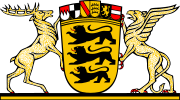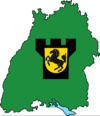Rosenstein Palace
| Rosenstein Castle | |
|---|---|
Schloss Rosenstein | |
 Baden-Württemberg's Coat of Arms | |
 View at Night | |
 Schloss Rosenstein Location in Baden-Württemberg | |
| Former names | Die Kahlenstein (German: The Bald Rock) |
| Etymology | Die Rosenstein (German: The Rose Rock), for the rock it sits upon. |
| General information | |
| Status | Complete |
| Type | Palace |
| Architectural style | Classical |
| Location | Rosenstein Park |
| Town or city | Stuttgart |
| Country | Germany |
| Coordinates | 48°48′3.6″N 9°12′21.6″E / 48.801000°N 9.206000°E |
| Elevation | 245 m (804 ft) |
| Named for | Rose garden on the palace grounds |
| Groundbreaking | 1824 |
| Construction started | 1824 |
| Completed | 1829 |
| Renovated | 1950–1960 1990–1992 |
| Demolished | 1944 |
| Client | State Museum of Natural History Stuttgart |
| Owner | State Museum of Natural History Stuttgart |
| Dimensions | |
| Diameter | 75 m × 47 m (246 ft × 154 ft) |
| Technical details | |
| Floor area | 3,235 m2 (34,820 sq ft) |
| Design and construction | |
| Architect | Giovanni Salucci |
Rosenstein Castle (German: Schloss Rosenstein) is a palace in Stuttgart, Germany. It was designed in the classical style by the architect and court builder Giovanni Salucci (1769–1845) as the summer palace for King Wilhelm I of Württemberg and was built between 1822 and 1830.
Today, the building houses that part of the State Museum of Natural History Stuttgart dealing with extant lifeforms.
Participating artists[]
Artists who participated in the construction and decoration of the palace were as listed below. Key to the abbreviations:
- NLE = No Longer Exists
- RE = Restored
- INT = Intact
Sculptors[]
| Status | Artist | Artworks |
|---|---|---|
| NLE | Two deer and two lions cast in bronzed zinc | |
| INT | Albert Güldenstein | Two large candelabras |
| INT | Albert Güldenstein | Four small candelabra on the ramps |
| NLE | Albert Güldenstein | Small candelabra: eight in side porticos and eight in loggias |
| INT | The Four Seasons stucco frieze in the ballroom | |
| INT | above the main entrance | |
| INT | Johann Michael Knapp | Lions Gate Archway |
| INT | Two muses | |
| INT | Venus of Phidias and Venus de Milo in the rose garden | |
| INT | on the rear façade | |
| INT | Six Muses, Small gable reliefs, four four garlands Friese, 16 medallions |
Painters[]
| Status | Artist | Artworks |
|---|---|---|
| NLE | Johann Friedrich Dieterich | Five ceiling frescoes in the dining room.[1] |
| NLE | Joseph Anton von Gegenbaur | Fresco in the dome and four frescoes in dome corners in the banquet hall; four frescoes in the Queen's library |
| NLE | Frescoes of the barrel vault in the ballroom |
Trivia[]
- Before the construction of the palace, the hill Rosenstein Castle stands on was called Kahlenstein (German: Bald Rock) as it was bare of trees. Afterwards, it became known as Rosenstein (German: Rose Rock) because of the rose garden southeast of the palace.
- Directly under Rosenstein Castle is Württemberg's first railroad tunnel.[2] Constructed between July 1844 and July 1846, the tunnel is 326 metres (1,070 ft) long[2] and was used until a new tunnel, located further east and not passing under the castle, was completed in 1915.[3]
References[]
- ^ Wenger, Michael (1995). "'Ein Meisterstück der Baukunst im ächt antiken Geschmack...'. Giovanni Salucci zum 150. Todestag. Ausstellung erinnert an den Baumeister". Schlösser Baden-Württemberg (in German). 2: 2–7.
- ^ Jump up to: a b Mühl, Albert; Seidel, Kurt (1980). Die Württembergischen Staatseisenbahnen (in German) (2nd ed.). Stuttgart: Konrad Theiss Verlag. pp. 40–41, 264. ISBN 3-8062-0249-4.
- ^ Dutt, Günter (1996). "Ein Streifzug durch 150 Jahre Tunnelbauwerke in Württemberg". Jahrbuch für Eisenbahngeschichte (in German). 28: 47–64. ISSN 0340-4250.
Categories:
- Castles in Stuttgart
- Museums in Stuttgart
- German castle stubs
- Baden-Württemberg building and structure stubs

